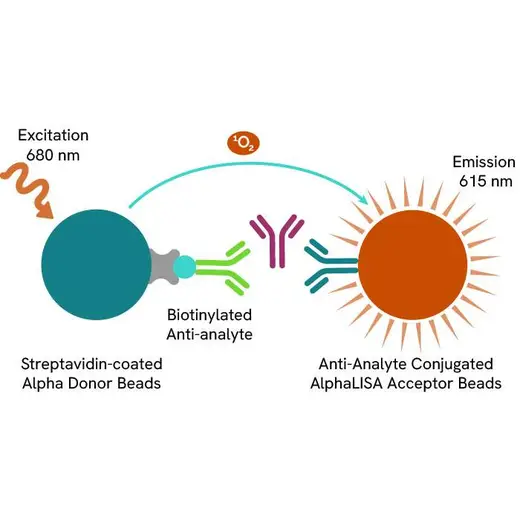
AlphaLISA Human Amyloid-β 1-40 High Specificity Detection Kit, 500 Assay Points


 View All
View All
AlphaLISA Human Amyloid-β 1-40 High Specificity Detection Kit, 500 Assay Points










The AlphaLISA™ immunoassay kit for human Aβ40 enables the detection and quantitation of human Aβ40 in human cerebrospinal fluid and cell culture supernatants using a homogeneous AlphaLISA assay (no wash steps). The assay shows negligible cross-reactivity with other forms of Amyloid beta (i.e. Aβ1-38 and Aβ1-42).
| Feature | Specification |
|---|---|
| Application | Protein Quantification |
| Dynamic Range | 42.2 - 10000 pg/mL |
| Limit of Detection | 42.2 pg/mL |
| Limit of Quantification | 89.0 pg/mL |
| Sample Volume | 5 µL |
The AlphaLISA™ immunoassay kit for human Aβ40 enables the detection and quantitation of human Aβ40 in human cerebrospinal fluid and cell culture supernatants using a homogeneous AlphaLISA assay (no wash steps). The assay shows negligible cross-reactivity with other forms of Amyloid beta (i.e. Aβ1-38 and Aβ1-42).





AlphaLISA Human Amyloid-β 1-40 High Specificity Detection Kit, 500 Assay Points





AlphaLISA Human Amyloid-β 1-40 High Specificity Detection Kit, 500 Assay Points





Product information
Overview
Formats:
- Our 100 assay point kit allows you to run 100 wells in 96-well format, using a 100 µL reaction volume (10 µL of sample).
- Our 500 assay point kit allows you to run 500 wells in 96-well or 384-well format, using a 50 µL reaction volume (5 µL of sample).
- Our 5,000 assay point kit allows you to run 5,000 wells in 96-well or 384-well format, using a 50 µL reaction volume (5 µL of sample).
AlphaLISA features:
- No-wash steps, no separation steps
- ELISA alternative technology
- Sensitive detection
- Broad sample compatibility
- Small sample volume
- Results in less than 3 hours
- Half the time of an ELISA assay
AlphaLISA technology allows the detection of molecules of interest in buffer, cell culture media, serum and plasma in a highly sensitive, quantitative, reproducible and user-friendly mode. In an AlphaLISA assay, a Biotinylated Anti-Analyte Antibody binds to the Streptavidin-coated Alpha Donor beads, while another Anti-Analyte Antibody is conjugated to AlphaLISA Acceptor beads. In the presence of the analyte, the beads come into close proximity. The excitation of the Donor beads provokes the release of singlet oxygen molecules that triggers a cascade of energy transfer in the Acceptor beads, resulting in a sharp peak of light emission at 615 nm.
Amyloid beta (Aβ) is a short peptide derived from a transmembrane protein, the amyloid precursor protein (APP), by proteolysis. The β- and γ-secretases cleave the respective N- and C-terminal ends of the Aβ sequence, liberating the Aβ peptide from APP. Aβ40 is the major species of Aβ produced by neurons and other cells, and accounts for over 70% of total Aβ produced, while the remainder is typically composed Aβ42 and other size variants ranging from 36 to 43 AA in length. Interestingly, it has been observed by some that the Aβ40/Aβ42 ratio increased in cerebrospinal fluid of AD patients. Aβ40 could be an important biomarker for detecting Alzheimer’s disease progression. This AlphaLISA kit has been designed to detect Aβ40 in cell culture supernatants and cerebrospinal fluid.
Specifications
| Application |
Protein Quantification
|
|---|---|
| Automation Compatible |
Yes
|
| Brand |
AlphaLISA
|
| Detection Modality |
Alpha
|
| Dynamic Range |
42.2 - 10000 pg/mL
|
| Limit of Detection |
42.2 pg/mL
|
| Limit of Quantification |
89.0 pg/mL
|
| Product Group |
Kit
|
| Sample Volume |
5 µL
|
| Shipping Conditions |
Shipped in Dry Ice
|
| Target |
Aβ40
|
| Target Class |
Biomarkers
|
| Target Species |
Human
|
| Technology |
Alpha
|
| Therapeutic Area |
Central Nervous System
|
| Unit Size |
500 assay points
|
Video gallery

AlphaLISA Human Amyloid-β 1-40 High Specificity Detection Kit, 500 Assay Points

AlphaLISA Human Amyloid-β 1-40 High Specificity Detection Kit, 500 Assay Points

Resources
Are you looking for resources, click on the resource type to explore further.
Targeted protein degradation (TPD) offers a promising approach for treating neurodegenerative diseases by selectively degrading...
Loading...


How can we help you?
We are here to answer your questions.






























